Content of the article

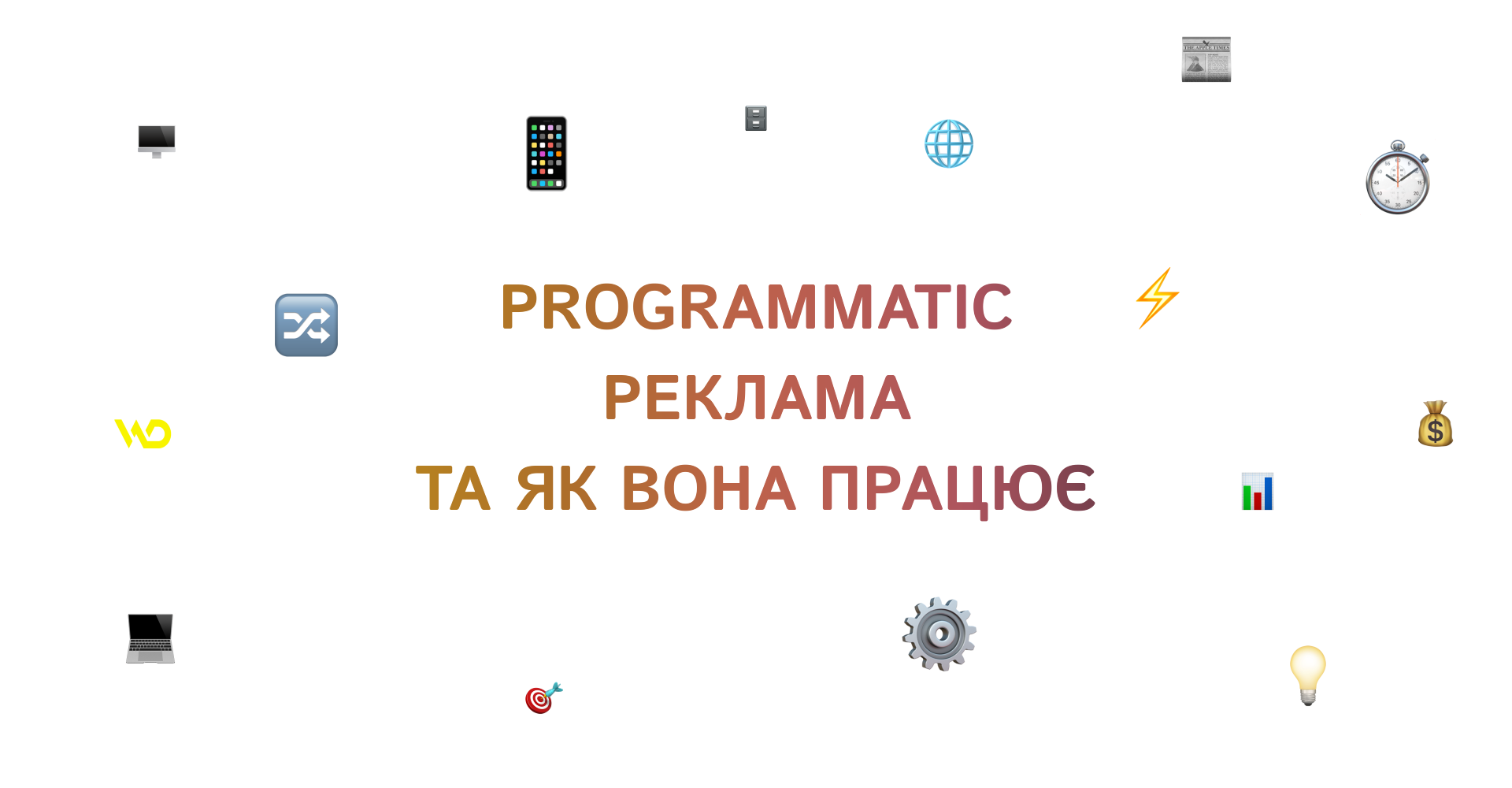
Modern digital marketing is evolving rapidly. Thanks to automation, data analytics, and real-time bidding, programmatic advertising allows you to optimize costs and significantly increase the effectiveness of your campaigns. In this article, we will discuss what programmatic advertising is, how it works, its characteristics, advantages and disadvantages, and trends.
What is programmatic advertising?
Programmatic advertising is an automated process of buying and selling digital advertising space through specialized technology platforms. It uses algorithms to conduct auctions in real time, allowing advertisers to
- customize your messages to the target audience as accurately as possible;
- respond promptly to changes in market conditions;
- effectively optimize the budget.
In addition, the integration of various technological solutions, such as demand-side platforms (DSPs), supply-side platforms (SSPs), ad exchanges, and data management systems (DMPs), makes it possible to analyze user behavior and improve advertising campaign strategies.
The main characteristics of Programmatic advertising
Programmatic advertising has four key characteristics that make it effective.
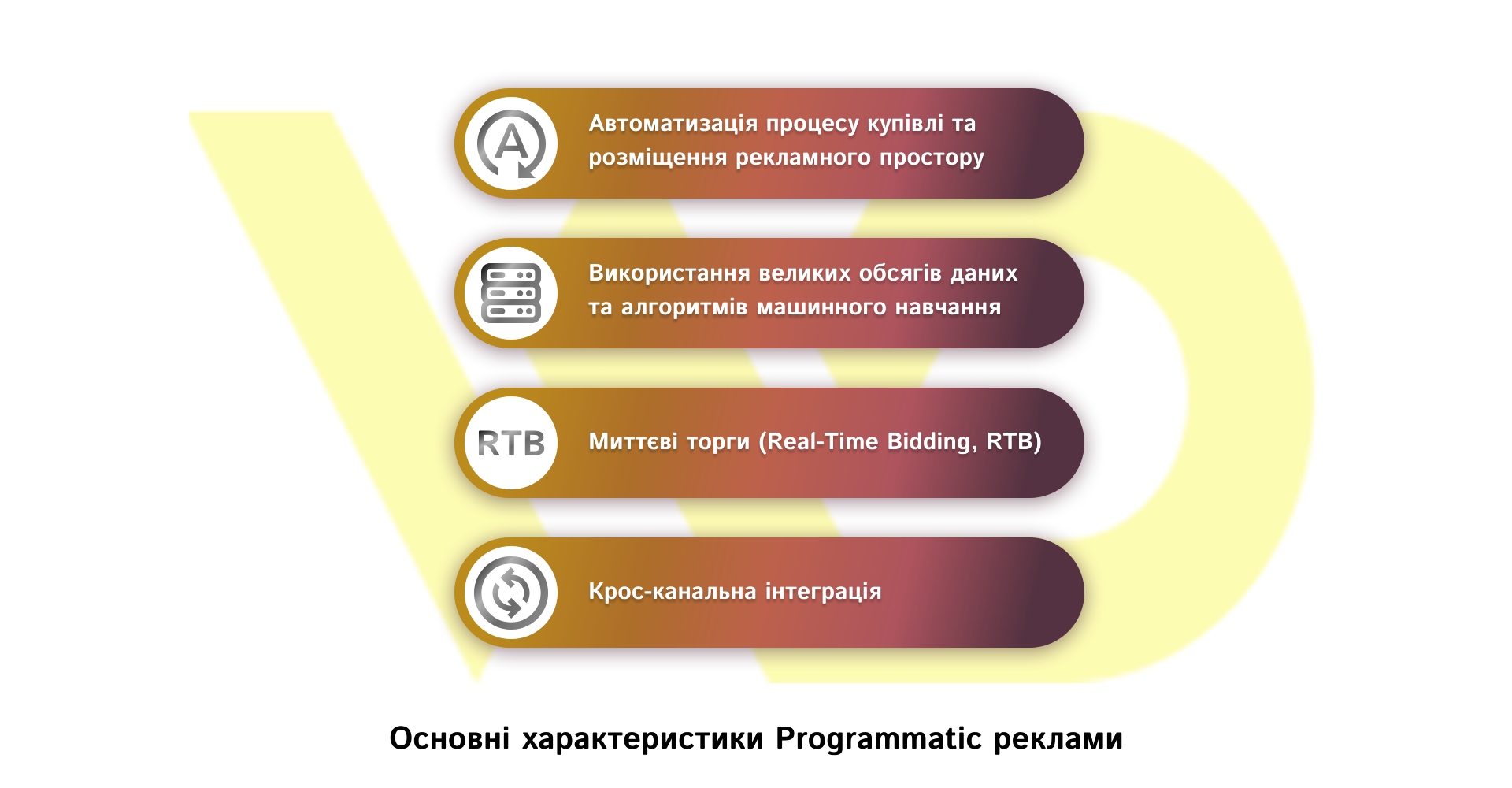
Automation of the process of buying and placing advertising space eliminates the need for lengthy negotiation processes, which significantly reduces the time to agree on terms and minimizes the risk of human error.
The use of big data and machine learning algorithms allows advertisers to perform precise targeting by analyzing user behavior, demographics, and interests. This makes advertising messages as relevant as possible to the audience, which increases conversions and optimizes costs.
Real-Time Bidding (RTB) allows you to determine the cost of each impression in real time and place bids based on detailed data analysis. This ensures that the advertising message is displayed to the user who has the highest potential to perform the targeted action.
Finally, cross-channel integration allows you to reach your audience on different devices and in different formats (banners, videos, native ads), which creates a single and consistent brand message regardless of the communication channel.
Thanks to these characteristics, Programmatic advertising ensures precise targeting, efficient use of the budget, and maximum relevance of communication with the audience.
How programmatic advertising works
The process of Programmatic advertising consists of several successive stages that are organically interconnected.
- Campaign settings.
At the initial stage, advertisers define campaign goals (increasing brand awareness, driving traffic, or increasing conversions) and allocate a budget through a demand-side platform (DSP). Next, adapted advertising creatives are developed, with which needs to conduct A/B testing. It is also necessary to segment the audience using modern analytics to ensure maximum relevance of messages.
For example, a leading online store seeking to increase sales during a seasonal promotion allocates a budget and creates personalized ads for new visitors, regular customers, and users who are most likely to purchase the product.
- Instant bidding (RTB).
When a user visits the site, the auction is launched and takes place in a matter of milliseconds. The DSP platform analyzes user data: demographics, behavior, context, and determines the optimal bid for the ad. Several advertisers participate in the micro-auction, and the ad with the highest bid is displayed on the user’s device.
For example, a travel agency that promotes favorable vacation offers uses this mechanism to dynamically display personalized ads to those users who are likely to make a reservation.
- Advertising delivery and optimization.
After the auction is won, the ad is delivered to the user depending on the device they are using – desktop, laptop, or mobile phone. Dynamic creative optimization systems allow you to adapt messages depending on the current context and user behavior. Continuous data collection on impressions, clicks, conversions, and real-time analysis allow you to quickly adjust campaign strategies to achieve the best results. Attribution models help determine the effectiveness of each touchpoint in the user experience.
To better understand, let’s look at an example. A user searches for a new smartphone from a laptop at home, and a few hours later logs into the social media app from his phone. Thanks to cross-device tracking and dynamic creative optimization, he sees an adapted ad: a detailed overview of the model on the computer, and a short promo video with a «Buy» button on the mobile version. The system analyzes his actions in real time and automatically adjusts bids and impressions to increase the likelihood of a purchase.
Key components of the ecosystem
The effective operation of Programmatic advertising is ensured by the interaction of several key elements. Each of them performs a separate function, and together they form a single system of automated ad buying and display.
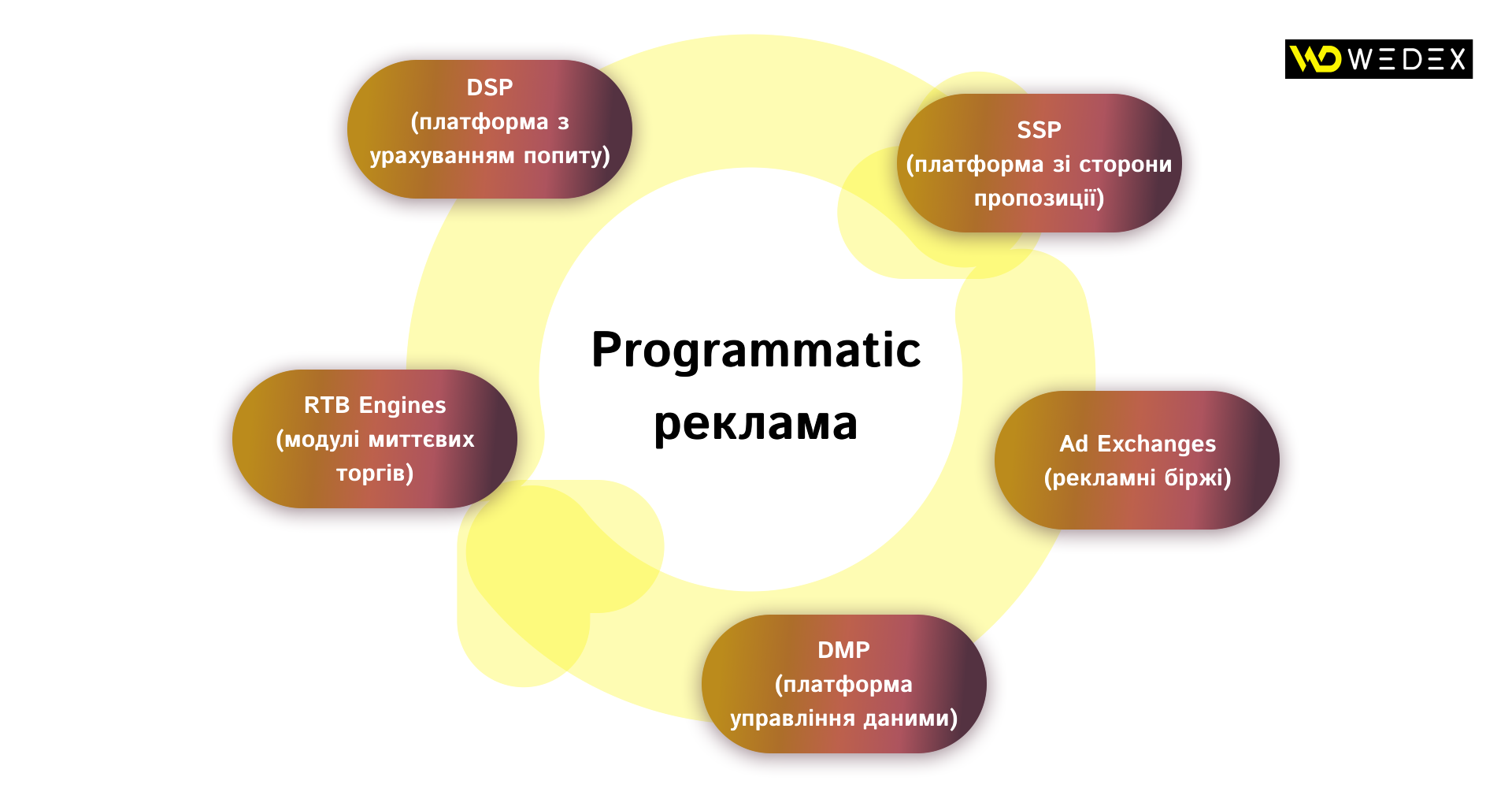
Let’s take a closer look at the main components that make Programmatic work.
- A Demand-Side Platform (DSP) is software that allows advertisers to manage campaigns, place bids, and purchase ad space. For example, a large online store uses DSP to automatically identify the audience that has recently visited their website. After that, it targets them with ads with promotional offers, which helps to increase sales.
- Supply Side Platforms (SSPs) are tools used by publishers to manage and sell their advertising inventory. For example, a large news portal integrates an SSP to automatically sell ad impressions to different advertisers through a real-time auction. This allows the publisher to maximize revenue for each ad space by optimizing the monetization of its traffic.
- Ad Exchanges are marketplaces where advertisers and publishers meet to conduct real-time auctions. For example, a travel company uses an ad exchange to advertise special offers, which helps to show ads to the audience planning a vacation.
- A data management platform (DMP) collects, stores, and analyzes user data from various sources, allowing you to create accurate audience segments. A financial company, for example, uses DMP to analyze the behavior of users interested in investment products, which allows it to increase conversions through personalized ads.
- RTB (Real Time Bidding) Engines are the technological core that conducts auctions for real-time ad impressions. For example, a food delivery company from uses RTB to show ads to users who are close to them, responding quickly to changes in demand during peak hours.
Thanks to this ecosystem, campaigns become more manageable, accurate, and effective.
Advantages and disadvantages of programmatic advertising
Of course, Programmatic advertising has its pros and cons, which should be taken into account before you start using it.
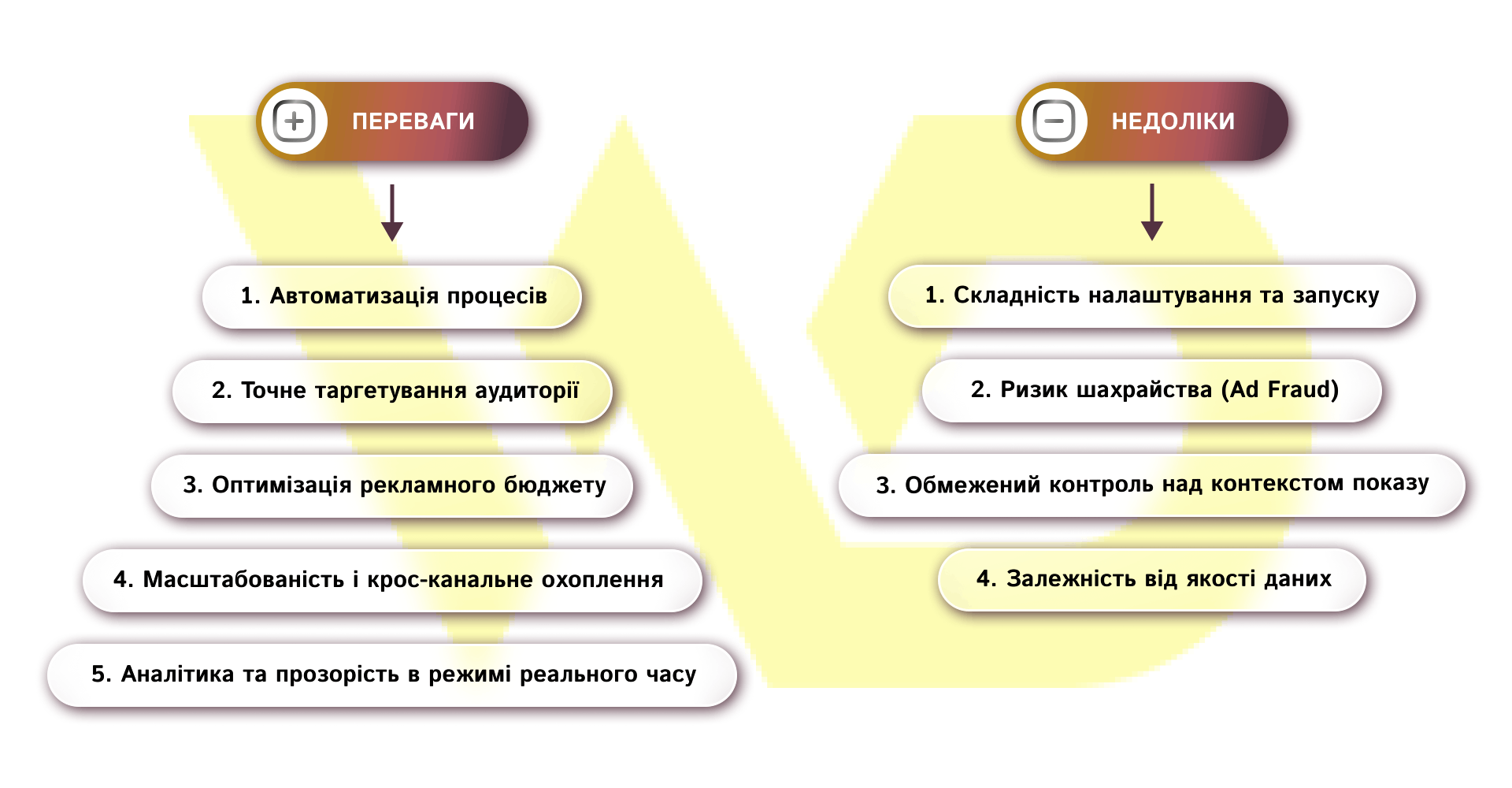
Let’s take a closer look at these features.
Advantages
- Process automation.
One of the main advantages is the full automation of ad buying and placement. In traditional advertising, this process often requires personal negotiations between the advertiser and the publisher, signing contracts, and approving layouts, which takes weeks or even months. Programmatic platforms (DSPs, SSPs) allow you to place ads instantly through a single interface. You can launch a campaign in a few clicks, and the system will independently conduct an auction and select the best platform for display.
- Precise audience targeting.
Unlike traditional channels, where ads are targeted at a wide audience (for example, television or outdoor advertising), programmatic allows you to show ads only to those users who are most interested in a product or service. By using data on behavior, interests, demographics, and geolocation, advertisers can personalize their message to the maximum extent possible.
For example, an online store can show a banner with winter shoes to users who have recently searched for similar products, and show another relevant offer to those interested in summer clothes.
Useful! Integrate your own CRM data with the DMP platform for even more personalized targeting.
- Optimization of the advertising budget.
Programmatic allows you to pay only for relevant impressions (CPM), clicks (CPC) or conversions (CPA). The Real-Time Bidding (RTB) auction model ensures the optimal cost for each placement, taking into account the probability of the target action.
For comparison, in TV advertising, you pay for thousands of impressions without knowing which viewers are interested. In programmatic, you show only those who are likely to buy the product.
- Scalability and cross-channel coverage.
Programmatic allows you to launch campaigns on many channels at once: websites, mobile applications, video platforms, social networks, and Digital Out-of-Home (DOOH). At the same time, you maintain a consistent style and brand message.
For example, a restaurant can show special offers on mobile devices in pedestrian areas, while the audience at home can see them in the form of video ads on Smart TVs.
- Real-time analytics and transparency.
Advertisers receive detailed reports on the effectiveness of their ads in real time: the number of impressions, clicks, conversions, and return on investment (ROI). Compared to outdoor or print advertising, it is difficult to measure the result offline – you don’t know how many people saw your ad and how many of them made a purchase. In programmatic, everything is under control – from the first impression to the purchase.
Useful! Set up automatic reports in DSP to quickly adjust bids and ads.
Disadvantages and how to avoid them
- Difficulty in setting up and launching.
To use programmatic advertising effectively, you need to understand technology, analytics, and targeting strategies. It is difficult for beginners to set up a campaign without making mistakes. To avoid this, hire experienced professionals or work with agencies that have access to premium tools and their own DMP.
- Risk of fraud (Ad Fraud).
Low-quality traffic, fake websites, and bots can eat up a part of your budget without bringing any real results. This is especially true when buying traffic at the lowest price. To avoid this, use anti-fraud services (IAS, DoubleVerify, Moat), connect Brand Safety filters, and create a whitelist of trusted sites.
- Limited control over the display context.
Sometimes an ad may appear on resources with unwanted or inappropriate content, which can negatively affect the brand’s reputation. Therefore, use Brand Safety tools and clearly define the categories of resources where ads are prohibited.
- Dependence on data quality.
If audience data is of poor quality or outdated, targeting efficiency plummets. To avoid this, regularly update your own first-party data, invest in collecting high-quality data, and use a DMP to integrate data from different sources.
Programmatic advertising offers much more opportunities for precise targeting, flexible campaign management, and increased ROI than traditional channels. However, it requires a professional approach to setting up and monitoring traffic quality. By taking these nuances into account, advertisers can maximize the effectiveness of their campaigns.
Current trends in programmatic advertising
Programmatic advertising is constantly evolving and adapting to the latest technologies and changes in user behavior. Today’s trends are:

Let’s take a closer look.
Modern advertisers use artificial intelligence and machine learning algorithms to analyze large amounts of data in real time, which enables more precise targeting and optimization of campaigns. This makes advertising as personalized as possible and meets the individual needs of each user.
Another important area is the growing popularity of advertising on Connected TV and OTT platforms, which allows brands to reach the audience of streaming services and display ads in a context where consumers are actively interacting with media content. In addition, digital out-of-home (DOOH) advertising is gaining popularity due to the ability to change the content on digital screens in public places depending on the time of day, weather conditions or other relevant factors.
As the volume of mobile traffic grows, advertisers are actively targeting mobile platforms using geo-targeting, which allows them to deliver messages in the right place and at the right time. At the same time, brands are increasingly switching to using their own data instead of third-party cookies, which increases the relevance of advertising and meets modern privacy requirements.
Automation and real-time optimization of campaigns is another important trend. Modern technologies allow you to instantly adjust your strategy based on the analysis of user behavior, which helps to reduce costs and increase efficiency. In addition, interactive advertising formats ensure active interaction between users and the brand, which makes advertising messages more attractive. Also, audio advertising, thanks to the growing popularity of podcasts and voice assistants, opens up new opportunities for delivering advertising messages in formats that meet current trends in content consumption.
The current trends in Programmatic advertising are focused on sustainability and environmental projects, when brands use advertising campaigns to promote socially responsible and environmental initiatives. Micro-targeting also allows advertisers to create narrow audience segments and deliver even more personalized messages, which significantly increases the effectiveness of campaigns.
These trends demonstrate how programmatic advertising is constantly adapting to modern market requirements.
Conclusions
Programmatic advertising is a powerful digital marketing tool that provides high targeting accuracy, cost optimization, and flexibility in launching campaigns. Thanks to automation and the use of real-time data, it significantly outperforms traditional advertising methods in terms of responsiveness and personalization.
Although there are some drawbacks to programmatic advertising, such as the integration of multiple platforms and technological complexity, modern tools and continuous optimization help minimize the risks. Thanks to the constant introduction of innovations such as artificial intelligence, expansion to new channels, and dynamic campaign adjustments, programmatic advertising continues to evolve and demonstrates a high potential for competitive advantage in the market.


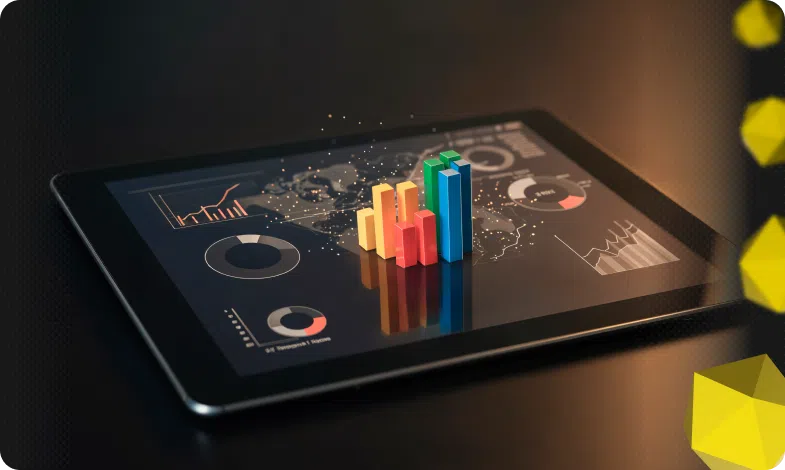
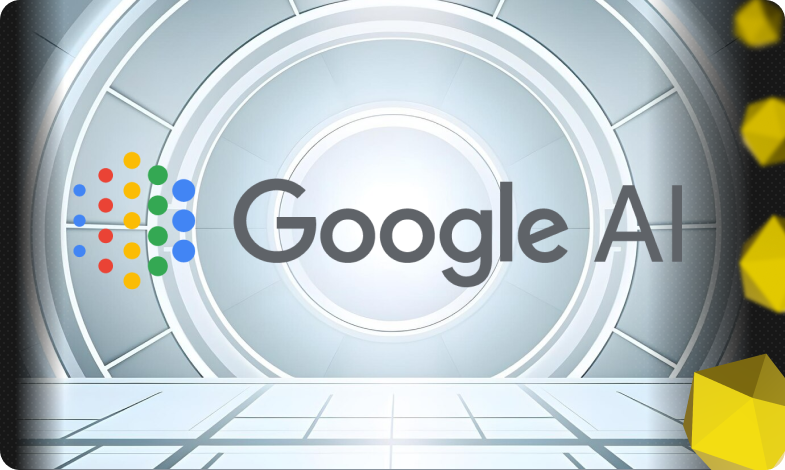



 12/06/2025
12/06/2025  1653
1653


